Pine Needle Tea vs Foods with Vitamin C
Jul 27, 2021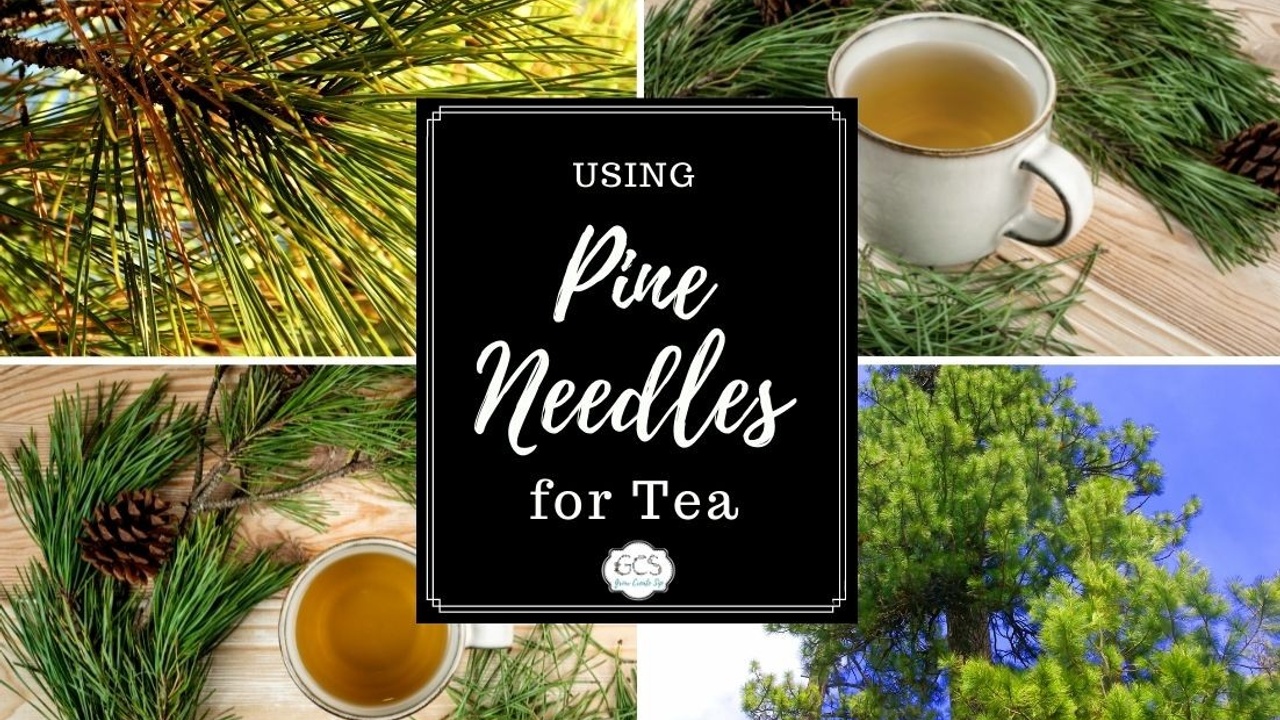
Pine needle tea, many will say is packed with vitamin c and shikimic acid, a constituent used to make a well-known antiviral drug, Oseltamivir, or as you may know it Tamiflu. While the news might be trending with pine needle tea, my question is, is it really the best tea and/or food for getting your vitamin c?
Fall is creeping up upon us and there are many herbs and foods to start harvesting and foraging for from rose hips, Oregon grape, elderberry, pine needles, and others depending on what area you live in.
Pine Needle Tea
Pine needle tea is made from the needles of many different kinds of pine trees including the Eastern White Pine and the Ponderosa Pine. While there are several pine trees you should not use, we will dive more into those in the pine needle dangers section below. The use of pine needle tea has been around for some time but became popular due to a statement from Real Housewive Star, Leanne Brown made a statement about it. We have received many questions about pine needle tea and today we want to share the ins and outs of pine needle tea. While pine needle tea has large amounts of vitamin c, large doses of evergreen teas can be toxic.
Before we start:
This herbal information is just that, information, not medical advice. This blog post and I DO NOT INTEND to treat, cure, or diagnose any disease or illness. This is for informational, educational and entertainment purposes only. Please consult a physician before using herbs medicinally.
This post also contains affiliate links. Translation: We get a little kickback for sharing certain products, at no additional cost to you, should you choose to purchase said items. And - thank you for supporting our farm and family! Read the full disclaimer here.

Pine Needle Tea Benefits
Let’s chat about the benefits of pine needle tea before we dive into the precautions. I highly recommend that you print out our free monograph journaling pages and do a deep dive into any plant before using it as medicine. Just because something is natural and foraged in the wild doesn’t mean it is safe or safe for everyone.
Pine needles tea benefits:
- Fevers, Colds & Coughs according to the Chestnut School of Herbal Medicine
- High Vitamin C (ascorbic acid) approx. 1.18 mg per gram of pine needle
- Diuretic
- Vitamin A content
- Hair & skin health
- Aides red blood cell production
- Expectorant
- Congestion
- Sore Throats
- Aides Bone Health
How to Make Pine Needle Tea
If you are blessed to have a pine tree or access to pine trees in order to forage for your own bine needles then it’s time to put those to work!
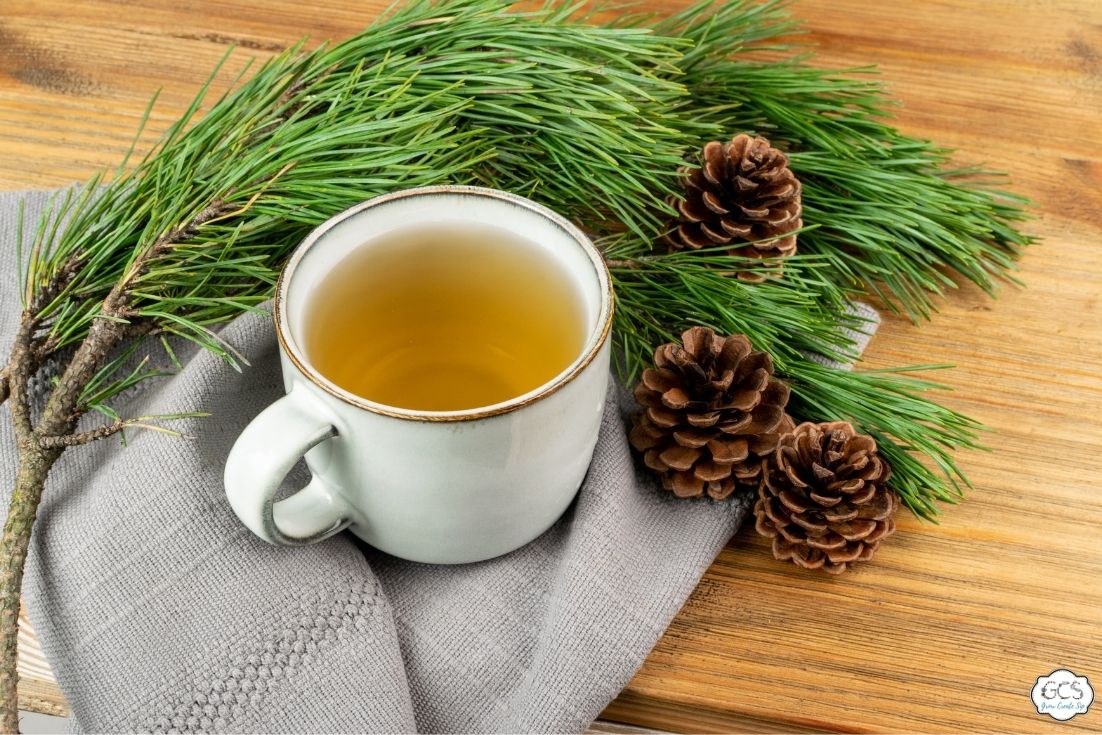
Pine Needle Tea Recipe
Ingredients
- 1 tablespoon of dried pine needles (from safe varieties)
- 1 tablespoon of dried peppermint
- 1 tablespoon of dried spearmint
- 8 cups of boiling water
- 8 cup French Press
- Raw Honey, optional
Instructions
- Add dried pine needles, and mints to french press
- Top french press off with boiling water
- Let steep for 5-7 minutes or desired to steep strength
- Pour into your favorite teacup or mug and add raw honey to taste. Enjoy!
Pine Needle Tea Dangers
Part of my reason for sharing about pine needles is because their sudden popularity with current world situations has created so much hype without any concern for their dangers. I have had customers email me wanting to know what it was about the pine needle tea that made their husband sick. Along with some who think that pine needle tea is going to be the cure-all herb. What we need to remember with using natural medicine or herbs as medicine is that they too have their dangers just as pharmaceutical drugs. They have precautions and they also interact with certain medications. And just like foods or drugs, some people can be allergic to them or react to them while some people may not.
Dangers when consuming pine needles may include but are not limited to:
- High amounts of Vitamin C can cause digestive issues, if you experience digestive issues (nausea, abdominal pain, stomach issues, diarrhea ect.) stop the use of pine needles
- Lookalike trees like, Yew or Cypress, have poisonous needles. Make sure when wild foraging that you know for sure what plant it is that you are using. It could make the difference between life and death.
- Consuming pine needles may be harmful to unborn babies, possibly causing miscarriage. Pine needle tea should not be consumed by pregnant or breastfeeding mothers.
- Anyone with allergies to pine or like species should avoid
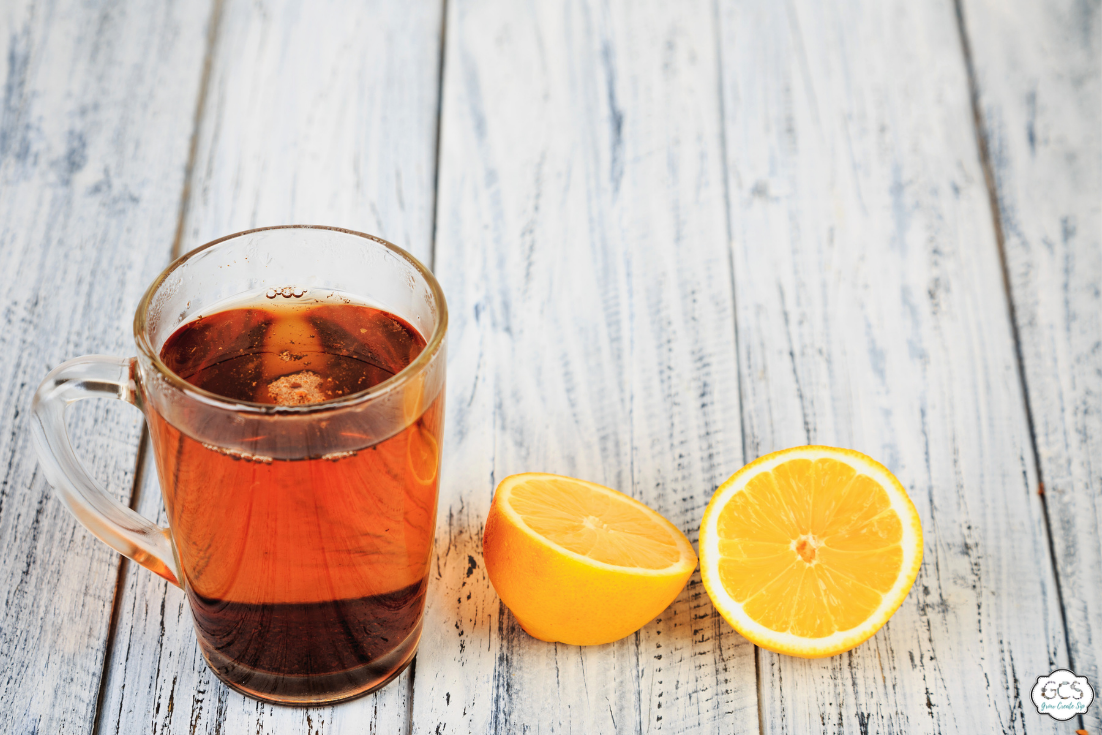
Vitamin C Benefits & Immune Vitamins
The benefits of vitamin c in the diet are many and some of them are well known. If you are looking for immune vitamins a.k.a. Vitamins that boost your immunity and making sure you get plenty of vitamin c foods and herbs in your diet is a must.
Some of the benefits of vitamin c are:
- Aiding Hearth Health
- Boosting the immune system
- Eye health
- Skin Health
- Boosts antioxidants that fight free radicals
- Aides in the fight against chronic illness and inflammation
- One study shows it helps to lower blood pressure
- While the verdict is still out on Vitamin c and the common cold one study suggests that higher doses worked better than lower doses over time
How Much Vitamin C Per Day
Harvard Health recommends that adults take no more than 2,000 mg per day which is the upper limit dosage, or to toleration. Above that, there may be some side effects. 75 mg a day is recommended for women unless pregnant or nursing and then 120 mg a day. 90 mg is recommended for men per day. Unless you have issues with kidney health, gout, calcium oxalate kidney stones, then it’s recommended to check with your doctor before using.
Too Much Vitamin C
Too much vitamin c long term really be a problem, like with most if not all things, moderation is key. Signs of too much vitamin c may look like a digestive upset in the form of diarrhea, heartburn, stomach upset, abdominal pain, nausea, gastritis, fatigue, insomnia, flushing, or a headache. If you encounter any of these things reduce or stop taking the vitamin c supplement, food, or herb.

Foods with Vitamin C
There are a great many foods that have vitamin c in them, most of us know all about oranges for instance and we just learned about the vitamin c in pine needle tea. Here are a few more foods, some more well-known and others that might be new to you, that rank high for vitamin c!
- Orange (.53 mg per gram)
- Lemon Peel (0.53 mg per gram)
- Rose hips (4.26 mg per gram)
- Hibiscus (0.184 mg per gram)
- Alma Fruit (4.45 mg per gram)
- Black Current (2 mg per gram)
- Dried Unsweetened cranberries (0.2 mg per gram)
- Carrots (0.05 mg per gram)
- Lime (0.29 mg per gram)
- Acerola Cherry (15-45 mg per gram)
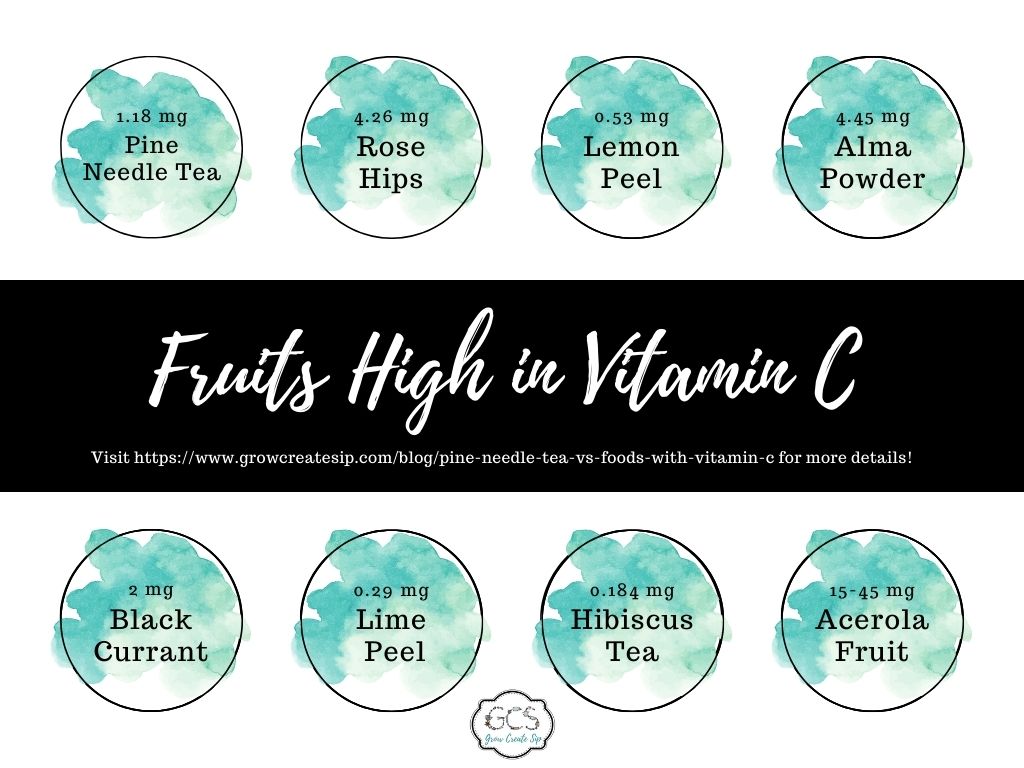
Lemon Vitamin C
Lemons are fabulous for so many things such as weight loss, detoxification, and more. We commonly add lemon slices or lemon juice to our water or to our sweet tea. Lemon while containing vitamin c containers lower amounts than other fruits at .53 mg to each gram. Lemons are easily accessible though and lemon peel dehydrated tastes fabulous in homemade teas and culinary dishes.
Find organic loose leaf teas with lemon in them here.
Rose Hip Vitamin C
Rose hips are a lesser-known form of vitamin c with their tart fruity flavor. Rose hips can be grown easily at home as a great sustainable way to provide you and your family with a reliable source of vitamin c. At just over 4 mg of vitamin C c per gram, this is a heaty runner in the options for a healthy vitamin c. I love that this one can be grown at home and it also tastes great and pairs with other herbs like hibiscus and cranberry to make a fabulous tasting tea. That makes one less herbal capsule or vitamin to take!
Find teas with rose hips in them here.
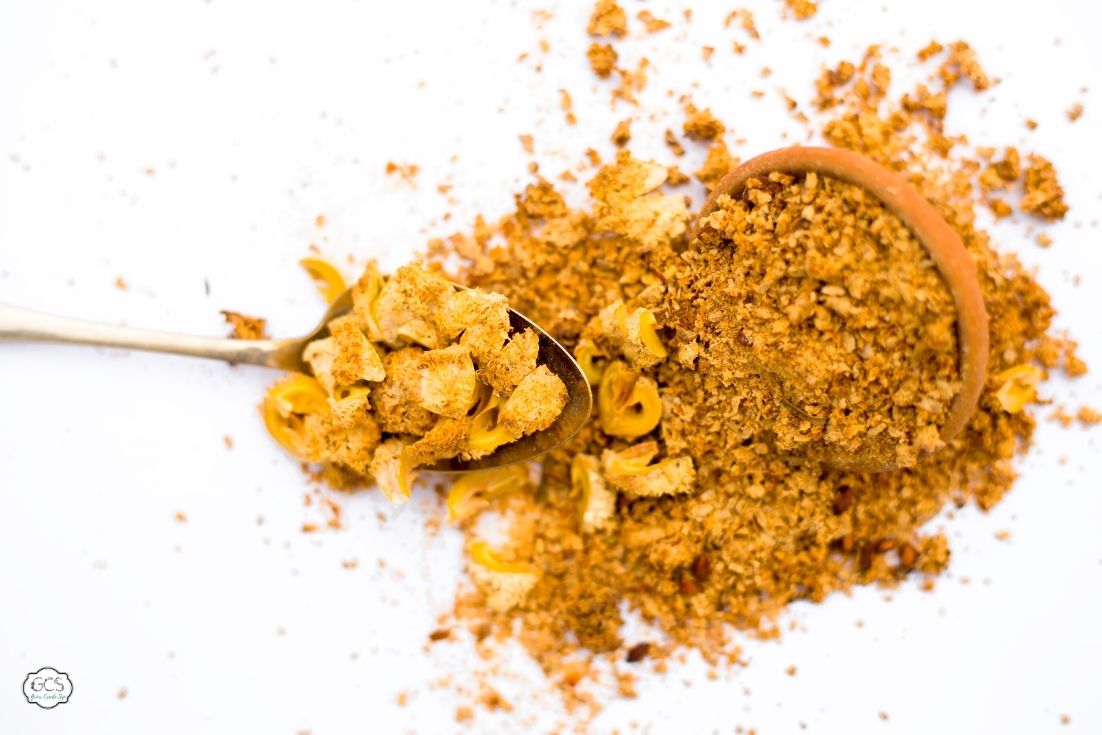
Amla Powder Benefits
Alma powder benefits are many including very high antioxidant levels which in turn aides chronic illnesses like diabetes, heart disease, and even cancer. Amla powder is also high in vitamin E and has been used in herbal vitamin c supplements for some time. Amla is also known as Indian Gooseberry used often by the Aryuvedic form of medicine in India. In India, it is used in a formulation called Triphala which is used in supporting the immune system and digestive system. Alma is naturally sour yet at the same time sweet, pungent, and bitter.
How Much Amla Powder Per Day
Alma dosage varies depending on the form of medicine as well as the person taking it. WebMd recommends for heartburn to take 1 gram 2 times a day for up to 4 weeks. While Ayurveda recommends ¼ to ½ teaspoon of powder 2 times a day or according to the recommendation of your doctor.

As you can see there are so many wonderful medicinal herbs and herbal immune vitamines that God placed around us. We have so many different options! Those options can be both overwhelming and useful at the same time.
Some of us, or many, may not have access to pine needles, or alma. But we may have an abundance of rose hips or orange peels. The wonderful thing about that is that we can use what we easily have access to.
When it comes down to pine needle tea, while it might be helpful in some ways. It can also be harmful if we are not able to identify the right tree to forage from or if we have a sensitivity to them.
Pine needle tea is also very difficult to purchase ready-made, it is not an ingredient that is widely available. Pine needle tea also doesn’t taste as fabulous compared to other herbs, spices, and botanicals that we have better access to. Learn to blend your own medicinal teas at home with our free tea blending workshop.
I’d love to know though! What are your thoughts on pine needle tea? Is it just a craze or will you be stashing some wild foraged pine needle in your apothecary? Let me know in the comments below.
Other posts you may enjoy:
- Aronia Berry + Elderberry Syrup Recipe
- Herbs for Allergies (Fight Seasonal Allergies)
- Herbal Allergy-Fighting Tea Recipe
- Tools for Preventing Colds, Coughs & Flu Part 1
- Herbs for Colds, Coughs & Flu Part 2
- Herbal Apple Cider Vinegar Gummies














